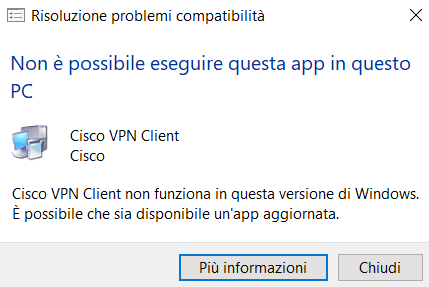

- Windows 10 compatible cisco ipsec vpn client how to#
- Windows 10 compatible cisco ipsec vpn client windows 10#
- Windows 10 compatible cisco ipsec vpn client windows 8.1#
There are a number of Universal Windows Platform VPN applications, such as Pulse Secure, Cisco An圜onnect, F5 Access, Sonicwall Mobile Connect, and Check Point Capsule. Using the UWP platform, third-party VPN providers can create app-containerized plug-ins using WinRT APIs, eliminating the complexity and problems often associated with writing to system-level drivers.
Windows 10 compatible cisco ipsec vpn client windows 8.1#
The Universal Windows Platform (UWP) VPN plug-ins were introduced in Windows 10, although there were originally separate versions available for the Windows 8.1 Mobile and Windows 8.1 PC platforms. It will attempt from most secure to least secure.Ĭonfigure Automatic for the NativeProtocolType setting in the VPNv2 CSP. The Automatic option means that the device will try each of the built-in tunneling protocols until one succeeds. When a VPN plug-in is used, the adapter will be listed as an SSTP adapter, even though the VPN protocol used is the plug-in's protocol.

SSTP cannot be configured using mobile device management (MDM), but it is one of the protocols attempted in the Automatic option. SSTP is supported for Windows desktop editions only. L2TP with pre-shared key (PSK) authentication can be configured using the L2tpPsk setting in the VPNv2 CSP. Built-in VPN clientĬonfigure the IPsec/IKE tunnel cryptographic properties using the Cryptography Suite setting in the VPNv2 Configuration Service Provider (CSP). This guide focuses on the Windows VPN platform clients and the features that can be configured. In Windows 10, the built-in plug-in and the Universal Windows Platform (UWP) VPN plug-in platform are built on top of the Windows VPN platform. The remote access server answers the call, authenticates the caller, and transfers data between the VPN client and the organization’s private network. In a typical VPN deployment, a client initiates a virtual point-to-point connection to a remote access server over the Internet. A VPN client uses special TCP/IP or UDP-based protocols, called tunneling protocols, to make a virtual call to a virtual port on a VPN server. Virtual private networks (VPNs) are point-to-point connections across a private or public network, such as the Internet.

The EOL designation for the Cisco VPN Client v5.-the most recent and stable version-means that newer operating systems, like Windows 10, are not officially supported by the client.
Windows 10 compatible cisco ipsec vpn client how to#
If you have upgraded from Windows 7/8 and need to install the Cisco VPN client then you can use the following instructions on how to cleanly install it or fix a bad install of it after upgrading to Windows 10.
Windows 10 compatible cisco ipsec vpn client windows 10#
Solving Windows 10 Cisco IPSec VPN Client Issue.Cisco L2TP (IPSEC) VPNs And Windows 10 - YouTube.


 0 kommentar(er)
0 kommentar(er)
